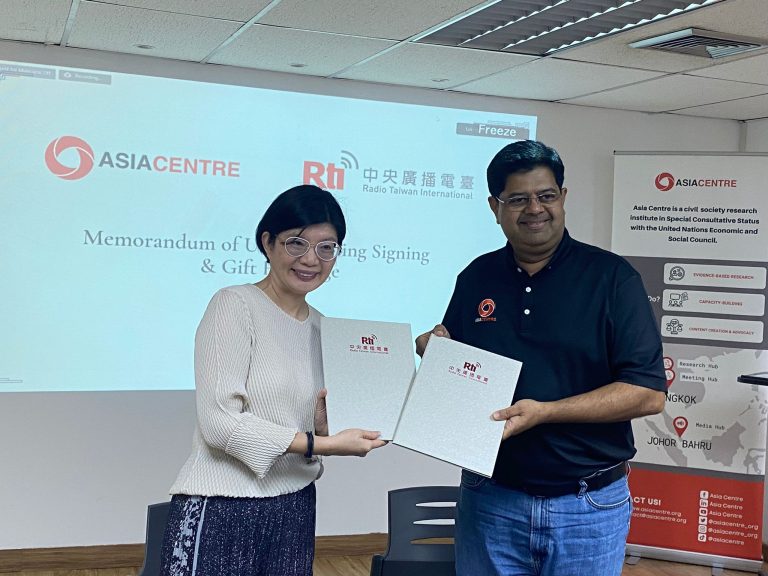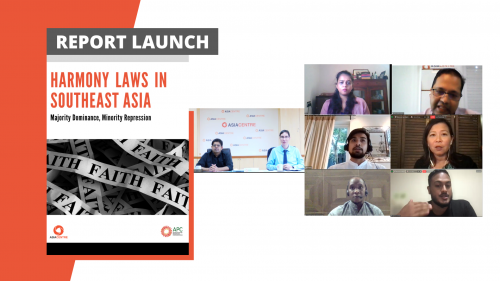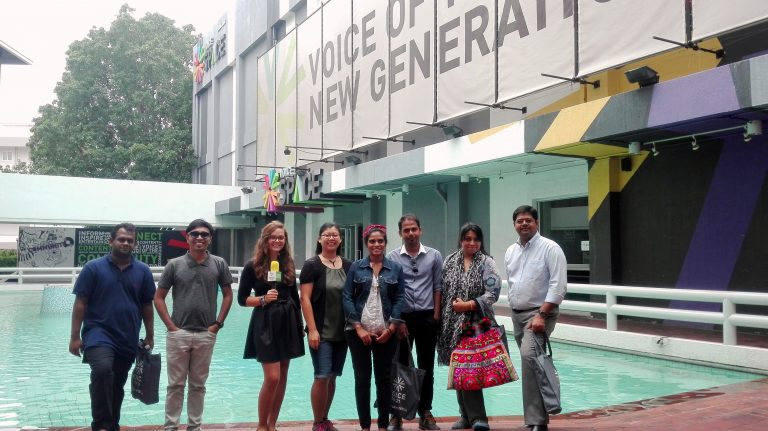An effective national human rights institution (NHRI) requires a creative, purposive interpretation of the mandate, and a proactive approach to implementation, this was one of the key takeaways from Asia Centre’s International Conference on National Human Rights Institutions in Southeast Asia: Challenges of Protection held on 13 and 14 July at the Centre’s premises in Bangkok, Thailand. The conference brought a diverse group of participants including representatives from United Nations, NHRIs and civil society for critical discourse into the effectiveness of the regions NHRIs. The conference also featured the UN Special Rapporteur on the Human Rights of Internally Displaced Persons, Ms. Cecilia Jimenez-Damary who will be presenting a report to the UN on NHRIs and displacement.

As independent, state-funded bodies with broad, internationally-endorsed mandates to protect and promote human rights, NHRIs serve as a vital bridge between the government and civil society, and play a distinct role in ensuring the effective implementation of international human rights standards at the national level. However, as conference discussions revealed the regions NHRIs are inundated with implementation challenges, ranging from opaque appointment processes to funding shortfalls to the lack of political will to investigate abuses. In Southeast Asia, NHRIs find themselves established in transitional or repressive regimes, posing unique obstacles to their promulgation of mandate.

Often, the effectiveness of the NHRI comes down to the initiative of the leadership and membership. As highlighted in several conference presentations, this initiative can be manifested in several ways, including making more regular, coordinated use of social media, increasing engagement with civil society, and developing greater sensitivity to issues of mental health, climate change, internal displacement, indigenous peoples, sexual orientation and gender identity, interreligious tension, and armed conflict. There are also opportunities to be explored on the regional level that will become increasingly relevant as some of the recently-established NHRIs mature, and as debates over the role of NHRIs continue to take place.
The Centre’s second conference was held in partnership with ASEAN-China International Studies Program and The Lutheran World Federation. It was supported by the Taiwan Foundation for Democracy.
Asia Centre Conferences: Designed for Discourse

The boutique conference assembled over 44 participants from across the ASEAN, New Zealand, Nepal, India, the U.S. and the U.K. Two of the six Southeast Asian NHRIs—the Myanmar National Human Rights Commission (MNHRC) and Indonesia National Commission on Human Rights (Komnas HAM)—were in attendance along with representatives from the New Zealand National Human Rights Commission. The two day conference’s program can be found here. Watch the conference’s video here.
 The nine panels were grouped thematically with presentation of research followed by questions and answers, feedback and discussion. The role of NHRIs was explored in different contexts, including in its relationship with civil society and regional human rights mechanisms, in achieving transboundary justice, and in various political and social environments. Country-specific discussions were held on Indonesia, Timor-Leste, Malaysia, Singapore, Myanmar, Thailand, Nepal, and the Philippines.
The nine panels were grouped thematically with presentation of research followed by questions and answers, feedback and discussion. The role of NHRIs was explored in different contexts, including in its relationship with civil society and regional human rights mechanisms, in achieving transboundary justice, and in various political and social environments. Country-specific discussions were held on Indonesia, Timor-Leste, Malaysia, Singapore, Myanmar, Thailand, Nepal, and the Philippines.
Day One
The first day focused on the mandate and broad principles underlying NHRIs, as well as the limitations and opportunities that they afford to NHRIs. Participants discussed the central question: to what extent are NHRIs limited by their mandate, and to what extent by other factors?
 In opening the conference, Cecilia Jimenez-Damary, UN Special Rapporteur on the human rights of internally displaced persons, highlighted the distinct advantage of NHRIs over academics and civil society in human rights protection, noting that they have a stamp of legitimacy in both the national and international context. Asia Centre Director Robin Ramcharan emphasized that while the mandates for NHRIs are generally broad, NHRIs will be ineffective unless they implement their mandate “creatively, purposefully, and proactively.”
In opening the conference, Cecilia Jimenez-Damary, UN Special Rapporteur on the human rights of internally displaced persons, highlighted the distinct advantage of NHRIs over academics and civil society in human rights protection, noting that they have a stamp of legitimacy in both the national and international context. Asia Centre Director Robin Ramcharan emphasized that while the mandates for NHRIs are generally broad, NHRIs will be ineffective unless they implement their mandate “creatively, purposefully, and proactively.”
The major takeaway here was that NHRIs, despite their limitations, can do more in terms of improving their advocacy and follow-up (such as by making better use of digital media) and that it is largely up to them to set higher standards. Participants brought up examples of best practises from around the world, including Kenya and New Zealand.
 The role of other stakeholders in the protection of human rights was also discussed. Participants explored the potential of regional mechanisms like ASEAN and its Intergovernmental Human Rights Commission (AICHR) in helping to strengthen NHRIs, as well as the role of corporations in protecting communities near resource extraction sites. Participants also debated the best approach for various sectors of civil society to take in interacting with NHRIs on human rights issues–how best to present criticism in a constructive manner? Overall, the need for greater, systematic coordination between different stakeholders and NHRIs was apparent.
The role of other stakeholders in the protection of human rights was also discussed. Participants explored the potential of regional mechanisms like ASEAN and its Intergovernmental Human Rights Commission (AICHR) in helping to strengthen NHRIs, as well as the role of corporations in protecting communities near resource extraction sites. Participants also debated the best approach for various sectors of civil society to take in interacting with NHRIs on human rights issues–how best to present criticism in a constructive manner? Overall, the need for greater, systematic coordination between different stakeholders and NHRIs was apparent.
Day Two
The second day honed in on the political and social contexts that  constrain and inform the work of NHRIs. Participants highlighted the need for NHRIs to develop greater sensitivity towards the rights of marginalized peoples, including the LGBT communities in Thailand and Malaysia, religious minorities and the mentally disabled in Indonesia, drug-affected populations in the Philippines, Filipino migrant workers in Japan, as well as internally displaced persons throughout the Asia-Pacific region. Through country-specific discussions on Timor-Leste, Singapore, and the Philippines, participants asked more fundamental questions about the future of NHRIs: Why would a state undergoing political crisis, or one that avowedly rejects human rights values, establish and promulgate an NHRI? Why would any state be incentivized to establish such an institution? Are NHRIs necessary in all states? Some of the questions challenged the very founding principles of NHRIs: Is independence necessary to an effective NHRI? To what extent should NHRIs take into account local laws?
constrain and inform the work of NHRIs. Participants highlighted the need for NHRIs to develop greater sensitivity towards the rights of marginalized peoples, including the LGBT communities in Thailand and Malaysia, religious minorities and the mentally disabled in Indonesia, drug-affected populations in the Philippines, Filipino migrant workers in Japan, as well as internally displaced persons throughout the Asia-Pacific region. Through country-specific discussions on Timor-Leste, Singapore, and the Philippines, participants asked more fundamental questions about the future of NHRIs: Why would a state undergoing political crisis, or one that avowedly rejects human rights values, establish and promulgate an NHRI? Why would any state be incentivized to establish such an institution? Are NHRIs necessary in all states? Some of the questions challenged the very founding principles of NHRIs: Is independence necessary to an effective NHRI? To what extent should NHRIs take into account local laws?
 The questions opened up the floor to discuss alternative pathways for rights protection. Participants explored the role of domestically-mandated investigative bodies, as well as the importance of participatory research in human rights investigation. Alternative conceptions of the role of NHRIs were also discussed. Michael White from the New Zealand Human Rights Commission and Dr. Khoo Ying Hooi, senior lecturer at the University of Malaya and co-convenor the conference, emphasized that full independence for an NHRI is unlikely given their essential status as state apparatuses. Going further, they argued that independence is not key to an NHRI’s effectiveness, and that the initiative and expertise of the commissioners mattered more than, and can compensate for, the lack of independence.
The questions opened up the floor to discuss alternative pathways for rights protection. Participants explored the role of domestically-mandated investigative bodies, as well as the importance of participatory research in human rights investigation. Alternative conceptions of the role of NHRIs were also discussed. Michael White from the New Zealand Human Rights Commission and Dr. Khoo Ying Hooi, senior lecturer at the University of Malaya and co-convenor the conference, emphasized that full independence for an NHRI is unlikely given their essential status as state apparatuses. Going further, they argued that independence is not key to an NHRI’s effectiveness, and that the initiative and expertise of the commissioners mattered more than, and can compensate for, the lack of independence.
Moving Forward—Opportunities and Challenges for NHRIs in Southeast Asia
 Overall, Asia Centre’s second conference was successful in creating a platform for participatory discourse among a diverse set of stakeholders crucial to effective NHRIs. It provided participants the opportunity to identify patterns of engagement with NHRIs, discuss the different academic narratives surrounding them, as well as share best practices. Presentations from the conference will be compiled into an edited volume to published by Palgrave Macmillan in the second quarter of 2018.
Overall, Asia Centre’s second conference was successful in creating a platform for participatory discourse among a diverse set of stakeholders crucial to effective NHRIs. It provided participants the opportunity to identify patterns of engagement with NHRIs, discuss the different academic narratives surrounding them, as well as share best practices. Presentations from the conference will be compiled into an edited volume to published by Palgrave Macmillan in the second quarter of 2018.
The compiled conference procedure can be found here. The conference leads to Asia Centre’s publication: National Human Rights Institutions in Southeast Asia: Selected Case Studies. It reviews Southeast Asia’s National Human Rights Institutions (NHRIs) as part of an emerging assessment of a nascent regional human rights architecture that is facing significant challenges in protecting human rights.



